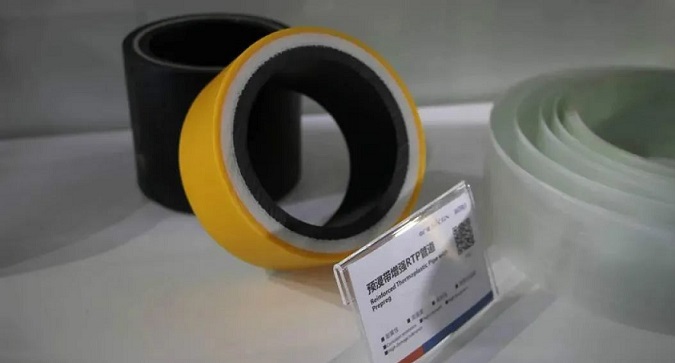Reinforced Thermoplastic Pipes (RTP pipes for short) are high-pressure plastic composite pipes with good flexibility, corrosion resistance, high pressure resistance, impact resistance, abrasion resistance, light weight, easy connection, It can be coiled and laid quickly without joints for long distances. It can well overcome the corrosion problems of steel pipes and the pressure problems of plastic pipes. It can be used in oil and natural gas extraction, high-pressure long-distance transportation of natural gas and various types of high pressure. The field of pipelines for conveying media.
1. The structure and material of the RTP tube
RTP products are usually composed of three layers, the inner and outer layers are made of PE80, PE100 or above, and the outer layer can be white (for anti-ultraviolet laying on the ground) or black (for buried laying) as required; the middle layer is reinforced by a composite of reinforced materials Belt, the reinforcing material can be high-strength fibers such as aramid fiber, polyester fiber or glass fiber.
Flexible reinforced thermoplastic composite pipes usually use high-density polyethylene (HDPE) grade 80 or higher plastics, high-strength fibers or steel wire ropes as the main raw materials. After extrusion, molding, winding, overcoating, coiling and other processes, the production length reaches the upper limit. Kilometers of high-pressure flexible pipes. Using different reinforcing layer materials and outer covering materials, various RTP pipes with different pressure levels and different properties can be obtained.
Compared with RTP pipes that directly use glass fiber or aramid fiber yarn and fiber bundles to wind, the fiber and resin cannot be completely infiltrated, so that the overall structural strength and compressive strength cannot be fully exerted, the continuous fiber reinforced prepreg is used The tape is wound, the tape itself has high tensile strength, and its performance is more stable and more uniform. It can integrate the inner and outer walls and the core reinforcement layer completely, and its various properties are more excellent.
The continuous fiber reinforced thermoplastic resin composite unidirectional prepreg tape used in RTP pipes is currently mainly aramid fiber and glass fiber reinforced unidirectional tape. Others such as basalt fiber, quartz fiber, and carbon fiber can also be used, depending on the application Comprehensive consideration of the field design.

2. Advantages of RTP tube
1. Corrosion resistance, the inner and outer walls of the RTP pipe have good anti-corrosion performance, which is suitable for a variety of corrosive media and various corrosive environments.
2. High pressure resistance, RTP tube has high pressure bearing capacity. By choosing different reinforcing materials, the maximum pressure can reach 32 MPa, and the burst pressure can reach more than 100 MPa.
3. Temperature resistance and heat preservation. The use temperature range of RTP tube is -42℃~102℃, which can meet the temperature requirements of most occasions; when the temperature difference is 30℃, the temperature drop is less than 1℃ per 100 meters.
4. Strong conveying capacity. The inner wall of the RTP pipe is very smooth, no scaling, no waxing, low flow resistance, abrasion resistance, and lasting conveying capacity, which reduces the maintenance cost of the conveying pipeline.
5. Good flexibility, RTP pipe has extremely high toughness, good impact resistance, strong resistance to soil settlement, earthquake, etc. At the same time, due to the flexibility of the RTP tube, natural compensation can be performed through the snake-shaped layout during installation, and no thermal compensation device is required, thereby saving installation costs.
6. Convenient construction. RTP pipes can be coiled and laid just like cables; the tensile strength is high. When laying pipes, the long-term maximum tensile force can reach 5 tons, and the instantaneous maximum tensile force can reach 10 tons.
7. There are few joints, and the length of a single RTP pipe can reach 150-400 meters, so there are few joints, higher reliability, and cost savings.
8. High performance-price ratio. According to the data of Viking Company in Germany, RTP pipe can save investment by more than 25% compared with carbon steel pipe.
9. Long service life, the conventional design life of RTP tube is 20 years, up to 50 years.
3.Application of RTP tube
Since being put into use for the first time in the UK in June 1995, RTP pipes have been widely used as oil and gas gathering pipelines in oil and gas fields, and have been rapidly promoted in other fields as long-distance pipelines with corrosion resistance and high pressure resistance, such as urban pipeline networks and natural gas. Transportation, chemical industry and other fields.
1. Petroleum and natural gas exploitation (oil collecting pipes, water injection pipes) and natural gas high-pressure transportation (diameter 50mm ~ 400mm, maximum pressure 25MPa) on land and shallow sea;
2. Offshore oil and natural gas exploitation (bridging pipes, circulation pipes and risers);
3. Submarine water pipeline;
4. Pipes for hydraulic transmission systems in mines and industries;
5. Urban and rural water pipelines;
6. Old pipeline repair project;
7. Fire pipes.

